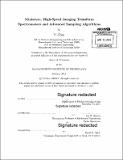Miniature, high-speed imaging transform spectrometers and advanced sampling algorithms
Author(s)
Chen, Yi, Ph. D. Massachusetts Institute of Technology
DownloadFull printable version (65.78Mb)
Other Contributors
Massachusetts Institute of Technology. Department of Mechanical Engineering.
Advisor
Ian W. Hunter.
Terms of use
Metadata
Show full item recordAbstract
This thesis describes the development of miniature imaging Fourier transform spectrometers and irregular sampling techniques. An imaging spectrometer is a device that takes a series of images that include information from a variety of wavelengths of light at high spectral resolutions. When this device is combined with different types of input light for absorption, fluorescence or Raman scattering experiments, it can be used to differentiate between materials that are indistinguishable to the naked eye in a nondestructive, non-contact manner. A variety of small devices that can fit in the palm of the hand or at the end of a robotic endoscope (up to 15 mm in diameter) are designed. The device could be set to several spectral analysis modes with resolutions up to 1.6 cm- 1 and is capable of producing continuous video. Such a device requires the design of custom optical, electrical, mechanical, and software systems. Small linear Lorentz force voice coil actuators, fast piezoelectric actuators, flexures, and miniature precision position and tip-tilt measurement systems are implemented and characterized. Feedback, feedforward, and high speed hybrid-actuator control systems are also used for fast step positioning at up to 2 kHz. It is also desirable to obtain spectra quickly, therefore methods for under-sampling and computing spectra with a small number of data points is explored. An adaptive sampling algorithm is devised and shown to outperform compressive sensing techniques for systems with larger occupancies (in the range of 10 % or more). For systems with less than perfect occupancy, adaptive sampling techniques can reduce the acquisition time for a spectrum by up to ten fold. Additional recursive update algorithms as well as uniformly sampled and non-uniformly sampling digital filtering algorithms were also explored in order to produce color video at 45 frames per second or faster from raw black and white data taken at 2010 frames per second without any physical filters. Finally, several applications for the imaging spectrometer are explored including the measurement of light sources like lasers and LEDs. The blood oxygen levels inside the human finger are also explored along with the response of dissimilar fluorophores under a microscope. Raman scattering spectroscopy is also conducted with the device to characterize materials like diamond. The work conducted with these instruments may lead to portable commercial devices in the future for a wide variety of applications including biology, environmental science, process monitoring, and material identification.
Description
Thesis: Ph. D., Massachusetts Institute of Technology, Department of Mechanical Engineering, 2015. Cataloged from PDF version of thesis. Includes bibliographical references (pages 291-303).
Date issued
2015Department
Massachusetts Institute of Technology. Department of Mechanical EngineeringPublisher
Massachusetts Institute of Technology
Keywords
Mechanical Engineering.